|
|
Sovereign Remedy
|
Published in Thailand Tatler Magazine
Society Issue - January 2006
|
Summer Palaces of the Thai Kings
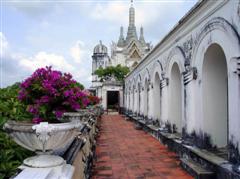 By Oliver Benjamin By Oliver Benjamin
At first blush, the idea of retreat often conjures up negative connotations. One thinks of surrender in warfare, the giving up of territory, or the loss of an argument. But the concept of retreat can be strategic and spiritual. As the Buddhist monk Thich Naht Hanh put it, “Don’t just do something, sit there.” He meant, of course, that it’s important for everyone to set aside some time to reflect, rest and rejuvenate. This is especially true for those who bear the pressure of enormous responsibility. And so it was for the great Thai kings of yesteryear, whose assortment of wondrous summer palaces stand as testaments to their annual periods of repose.
Spiritual retreat has its origin in earliest Buddhism. Before there were monasteries, the peripatetic Buddhist monks took shelter during the monsoon for a period of three months. They did so not only for their own health, but because their trekking through the fields might threaten to crush the new rice seedlings. Eventually the modest buildings they stayed at evolved into the more permanent and ornate structures they are today and the monks’ travels became mostly limited to daily alms walks. Yet though their lives are now outwardly easier, their travels now consist of intense inner exploration. A retreat in this sense is not an “escape,” but a place to channel energies toward solving the most challenging problems one has to face.
The Prussian leader Fredrick the Great named his famous summer palace Sans Souci, French for “Far from Worries.” Yet for ardent leaders of any nation, worries are never really far away. In their summer palaces, a step removed from their normal lives, the Thai kings often wrestled with difficult, tumultuous and even tragic problems which brought out the finest aspects of their characters, unveiled their greatest hopes, and left an indelible mark on their nation.
Rama IV - King Mongkut
No Thai king understood the value of retreat better than Rama IV. By the time he was called to the throne at age forty-six he had been a monk for twenty-six years. During his monkhood he spent most of his time at Wat Maha Samanaram, at the foot of Khao Samana hill in Petchaburi. Having grown so fond of the place, he returned as king and built his summer palace there. Phra Nakorn Khiri (“Celestial City on a Hill”) is an enormous interlinked complex featuring impressive structures on each of the hill’s three peaks.
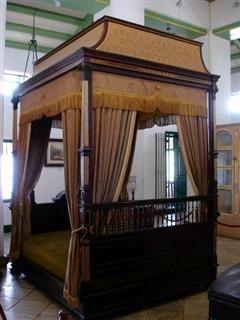
Mongkut’s choice of architecture at Phra Nakorn Khiri reflects his then-revolutionary attitude of integrating and interfacing with foreign powers: It showcases an unusual mix of styles, from Iberian to Dutch, Chinese, Thai and Khmer. The complex even boasts an Italianate observatory from which Mongkut ably studied the heavens. An avid scientist and astronomer, his lifelong desire to bring reason into Thai culture culminated in his remarkably accurate prediction of a solar eclipse in 1868. Prior to this, royal astronomers purveyed the notion that eclipses occurred when Rahu, a giant lion god ate the sun. Though he triumphantly proved them wrong, it cost him his life – on the expedition to view the eclipse, about a hundred kilometers south of Phra Nakorn Khiri, the monarch contracted malaria and died shortly thereafter. His sacrifice bore fruit, however – inculcating a great appreciation for reason, truth, and the cross-fertilization of cultures in the heart of his fifteen-year old son, the future Rama V.
Phra Nakorn Khiri
The western peak of Khao Samana hill hosts the residential buildings of Phra Nakorn Khiri, called Khao Wang (“Palace Hill”) by locals. The king’s residence is an airy, western-styled building called Phetchaphum Phairot Throne Hall. It contains a bedroom and study, dressing room and dining room. Several of the king’s possessions are on display, from furnishings to sculptures to traditional weapons. Adjacent to the throne hall is the Queen’s living quarters, the Pramot Mahaisawan Hall. Beside these buildings is Wetchaya Wichian Maha Prasat, the center of worship for the complex.
The two-story astronomical observatory, Chatchawan Wang Chai, affords a fantastic view over the other structures on the hill, and indeed all of Petchaburi. The other two peaks contain places of worship in the Thai style; the middle peak of the hill is topped with a large white chedi called Phrathat Chomphet, and the eastern peak features Wat Phra Kaew, and a red chedi called Phra Sutthasala. Chinese architecture is also employed here, in Rama IV’s two story bedroom, Pramot Mahaisawan.
The entire hill is covered with an aromatic forest of frangipani trees. Much less agreeable to the senses are the hundreds of pig-tailed macaques that have grown far too accustomed to being fed by visitors. According to some reports, these monkeys were a problem even in Mongkut’s time. Today, many of the vendors at the complex use slingshots to keep them at bay.
Both Rama IV and Rama V used Phra Nakorn Khiri for leisure and to entertain visitors, but after the death of the latter it fell into disuse and decay. Finally in 1935 the government declared it a national monument, restoring it to look much as it did back when it was the first summer palace (that is, outside of Bangkok) of the Chakri dynasty.
Rama V – King Chulalungkorn
The son of Mongkut, Chulalungkorn carried on his father’s revolutionary attitudes. Since his reign was a much longer forty-two years, however, he had the chance to accomplish far more than his father might have ever dreamed.
The period of Chulalungkorn’s reign was a difficult time for Asia as a whole – foreign colonial powers had carved up the entire continent between them with only Japan and Thailand holding on to sovereignty. Taking the ideas of his father to heart, he successfully managed to strategically ally himself w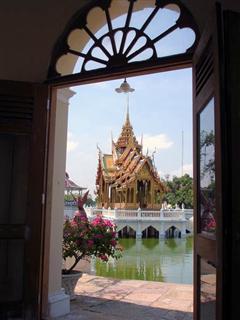 ith various powers at various times, thereby parrying their “divide and conquer” tactics with his own “divide and coerce” stratagem. Architecture played a surprisingly important role in this: by honoring the cultures of visiting dignitaries, he could remain in their good graces and assure them that Thailand was no backward, uncultured fiefdom, but a promising bastion of reason among its neighboring, relatively lawless lands. In taking the best of what he saw from Europe and mixing it harmoniously with Thai styles, he demonstrated that his culture could coexist and form alliances with the colonial forces, thereby saving Thailand from the fate of more ill-prepared nations. ith various powers at various times, thereby parrying their “divide and conquer” tactics with his own “divide and coerce” stratagem. Architecture played a surprisingly important role in this: by honoring the cultures of visiting dignitaries, he could remain in their good graces and assure them that Thailand was no backward, uncultured fiefdom, but a promising bastion of reason among its neighboring, relatively lawless lands. In taking the best of what he saw from Europe and mixing it harmoniously with Thai styles, he demonstrated that his culture could coexist and form alliances with the colonial forces, thereby saving Thailand from the fate of more ill-prepared nations.
Bang Pa-In
Rama V found Bang Pa-In ideal as a locale for a summer palace for a variety of reasons, though perhaps the most important was that it’s natural isolation on an islet in the middle of a river afforded some much-needed peace and privacy, “far from the madding crowds.”
The king’s architectural ambitions proved unbounded at Bang Pa-In – he installed a series of buildings that aimed to recreate virtually every respected style of architecture somewhere on the estate.
Thewarat Kanlai (“The King of the Gods Goes Forth”) Gate, studded with statues of cherubs, is Italian Neo-Classical. The red and yellow Ho Withun Thasana tower (“The Sage’s Lookout”) is largely Moorish. Varobhas Bimarn Throne Hall is a mixture of Corinthian and French Baroque. Uthayan Phumisathian Mansion is Swiss Chalet mixed with Art Nouveau. Of course, though Chulalungkorn made a special point to embrace European culture, he also paid great respect to the architecture of Asia: Bang Pa-In’s most emblematic building is the Aisawan-Dhipaya-Asana Pavillion (“The divine seat of personal freedom”), a classical Thai sala placed majestically in the middle of the site’s principal pond. And surely the most strikingly ornate building is the Wehart Chamrun Residential Hall, a masterpiece of Chinese handiwork which took some ten years to construct and which was financed by the Chinese chamber of commerce in 1889 as a symbol of loyalty to the Thai crown. More mode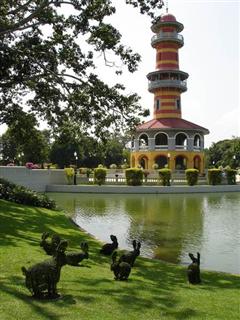 st but no less significant, a Khmer-style prang pays respect to the Ayutthayan king, Prasart Thong, the first to use the site as a royal residence. st but no less significant, a Khmer-style prang pays respect to the Ayutthayan king, Prasart Thong, the first to use the site as a royal residence.
Yet amidst this incredible mélange of styles, perhaps the most unusual is the Niwet Thamaprawat Temple, a Buddhist Wat unlike any other in Thailand in that it was designed to resemble a French Gothic church. Inside, a portrait of Chulalungkorn is even fashioned from stained glass. It is a testament to both Chulalungkorn’s preternaturally open mind and the flexible nature of Buddhism that such an overtly Christian building could be employed as a house of Buddhist worship.
Though Chulalungkorn’s 42-year reign was full of good fortune, it was also tarnished by an important and tragic loss, one that is memorialized at Bang Pa-In by a stark white marble monument.
On the way from Bangkok in 1880 to summer retreat in Bang Pa-In, his first Queen consort, Sunanda Kumariratana died along with her children when the boat she was traveling in overturned in the Chao Praya river. Though s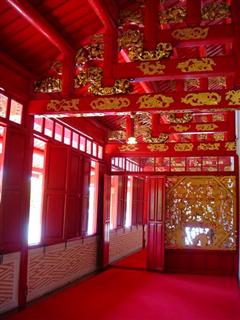 he might have easily been saved, a court guard followed royal codes to the letter and forbade anyone from touching her, an offense normally punishable by death at the time. Pregnant and trapped in the vessel, she quickly drowned. Chulalungkorn was devastated that his favored Queen and his offspring had died under such regrettable circumstances and took it upon himself to administer the religious rites for her cremation. As for the offending guard, he was demoted and jailed for his catastrophic judgment. he might have easily been saved, a court guard followed royal codes to the letter and forbade anyone from touching her, an offense normally punishable by death at the time. Pregnant and trapped in the vessel, she quickly drowned. Chulalungkorn was devastated that his favored Queen and his offspring had died under such regrettable circumstances and took it upon himself to administer the religious rites for her cremation. As for the offending guard, he was demoted and jailed for his catastrophic judgment.
On the day of the ritual, special permission was granted for the public to join him in bidding farewell to his love. Though he erected a series of monuments in the Queen’s honor, the one at Bang Pa-In bears special significance because this was her favorite location out of all in the kingdom.
Phra Ram Rachaniwet
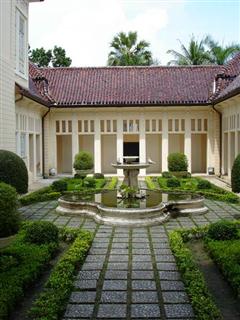 Late in his life, Chulalungkorn built Phra Ram Rachaniwet, another summer palace very close to his father’s in Petchaburi,. It was designed by a German architect named Karl Döhring to resemble Kaiser Wilhelm’s own summer palace in Germany, and featured a mixture of baroque and art nouveau styles. Late in his life, Chulalungkorn built Phra Ram Rachaniwet, another summer palace very close to his father’s in Petchaburi,. It was designed by a German architect named Karl Döhring to resemble Kaiser Wilhelm’s own summer palace in Germany, and featured a mixture of baroque and art nouveau styles.
Chulalungkorn was often sick during the monsoon and for the sake of his health it was decided that this area would be more salutary for him when the rains came. Sadly, his illness grew more severe and he died before building was finished. His son, Rama VI oversaw the final construction, complete in 1916.
The dining room is a blend of German and French art nouveau. The walls are studded with tiles bearing fanciful European-style motifs of animals and ornaments, even a few Christian ones. A statue of Poseidon overlooks the dining table from a niche in the far wall. Just outside this roo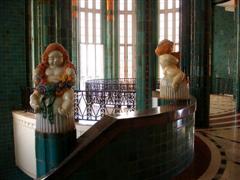 m, an enclosed courtyard with a fountain had once been Thailand’s first badminton court. Going upstairs, a perfectly geometrical, symmetrical circular staircase is decorated with ceramic cherubs, and leads up to a second floor landing decorated in art nouveau style. The Queen’s bedroom had a view over the badminton court, while the King’s bedroom enjoyed a view of Phra Nakorn Khiri, his father’s own summer palace. Having died when Rama V was only fifteen, Chulalungkorn missed his father greatly his whole life. It seems that in constructing this final palace with a full view of his father’s he hoped to live out his last days honoring the legacy and wisdom the great king bequeathed him. Sadly, it was not to be. Nevertheless, Phra Ram Rachaniwet was enjoyed from time to time by Rama VI, who stayed here when visiting nearby Chao Samran beach, the initial location of his own summer palace. m, an enclosed courtyard with a fountain had once been Thailand’s first badminton court. Going upstairs, a perfectly geometrical, symmetrical circular staircase is decorated with ceramic cherubs, and leads up to a second floor landing decorated in art nouveau style. The Queen’s bedroom had a view over the badminton court, while the King’s bedroom enjoyed a view of Phra Nakorn Khiri, his father’s own summer palace. Having died when Rama V was only fifteen, Chulalungkorn missed his father greatly his whole life. It seems that in constructing this final palace with a full view of his father’s he hoped to live out his last days honoring the legacy and wisdom the great king bequeathed him. Sadly, it was not to be. Nevertheless, Phra Ram Rachaniwet was enjoyed from time to time by Rama VI, who stayed here when visiting nearby Chao Samran beach, the initial location of his own summer palace.
Rama VI – King Vajiravudh
In contrast to the more autocratic methods of his father, Rama VI attempted to influence his populace chiefly through instructive dramas and articles, often written under a series of pen names. It was at Mrigadayavan Villa, his summer palace in Cha-am where his great love of theater and romance reached their fullest fruition and he enjoyed the last and happiest years of his life. Whereas, his more practical side was exercised at his other summer palace, Sanam Chan. There he oversaw the formation and training of the seua pa or “Wild Tiger” association, a guerrilla squadron conceived to fight off the continuing threat of European invasion.
Sanam Chan Palace
The style of buildings at Sanam Chan Palace in Nakorn Prathom vary from Thai to Western or Western-influenced. Some of the buildings were already extant when Rama VI was coronated, but he added additional ones later. Normally buildings of the same style were built two at a time, as is the case with Phra Thinang Phimanpathom and Phra Thinang Apiromreudi, both built in European style. When he ascended to the throne, Rama VI added two more, these more in accordance with traditional Thai aesthetics. Playing host to both of King Vajiravudh’s fondest achievements, Phra Thinang Samakkhimukmat was used both as a theater and as a meeting place to host seua pa gatherings. It was built in traditional Thai fashion with double roofs of glazed tile and all the requisite architectural details. It also functioned as his throne hall. Its sister building, the Phra Thinang Watchariromaya differs in some of its ornamental features. All four of the Phra Thinang are joined to each other by airy verandas and bridges, similar in style to his other summer palace, Mrigadayavan Villa. Some other structures erected here by Rama VI are in Western style, notably Tamnak Ya-Le, which resembles a medieval castle and was named for the king’s beloved dog, in whose honor he also erected a bronze monument.
Today some of the buildings the palace are used by government officials and others by Silpakorn University. Thus, King Vajiravudh’s legacy at Sanam Chan continues to honor both of his principal interests: administration and the arts.
Mrigadayavan Villa
King Vajiravudh had already built much of this palace at a different location, Samran beach, when it was discovered that the water supply there was woefully inadequ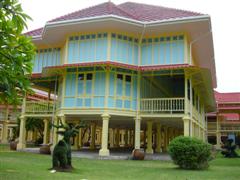 ate. He was obliged to dismantle the entire construction and move it to a more idyllic and practical location at Cha-am beach. Construction was completed in 1924. Fashioned from the finest golden teak (“thong”) and built in the style of traditional Thai houses, it is suspended entirely above ground on stilts, 1080 in total. To prevent insects from crawling into the estate, small canals around the base of each stilt were filled with water. Each building is connected by open-air walkways of brilliantly polished and lacquered golden teak, a rare and exceptionally beautiful hardwood. The complex was designed by Ercole Manfredi, an Italian architect. ate. He was obliged to dismantle the entire construction and move it to a more idyllic and practical location at Cha-am beach. Construction was completed in 1924. Fashioned from the finest golden teak (“thong”) and built in the style of traditional Thai houses, it is suspended entirely above ground on stilts, 1080 in total. To prevent insects from crawling into the estate, small canals around the base of each stilt were filled with water. Each building is connected by open-air walkways of brilliantly polished and lacquered golden teak, a rare and exceptionally beautiful hardwood. The complex was designed by Ercole Manfredi, an Italian architect.
Rama VI used the main hall of the palace as a theater to put on his plays. Samosorn Sewakamart Hall had no walls at all, open on all sides to let in the balmy sea breezes.
Mrigadayavan Palace came to be called the “Royal Home of Love and Hope” because of events that happened at the end of Rama VI’s life.
His Queen, Indrasakdi Sachi had become pregnant four times but each time could not bring them to term. It was the king’s greatest hope that they produce an heir together, but a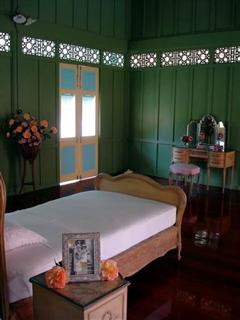 s they were growing older it seemed likely that this might never happen. s they were growing older it seemed likely that this might never happen.
It was at Mrigadayavan that the king found release from the challenges of administrating a modernizing state, the increasing disloyalty of the nobility and recurrent threats of military coups. He did so by indulging in his passion for theater, writing and producing plays in which he would often act in a minor role as well.
During a performance of one of his plays, on his first official retreat at the palace, fate brought the king and his future consort Tew Abhaiwongse together. A young actress and singer, she had already taken part in some of the king’s plays but this time her role necessitated that she interact directly with the monarch, who was acting a minor part as usual. One scene required Tew to touch the face of the king, which caused an uproar in the royal court. Naturally, Queen Sachi was the one most incensed, and incited the audience to disrupt the performance in protest. Vajiravudh, who placed his artistic integrity above courtly decorum, would not stand for it and reprimanded his wife sternly in front of the entire assembly.
After that incident, the Queen fell out of his favor and the king focused his interests on the young actress instead. He ultimately invited her to become his royal consort and gave her the esteemed name “Chao Chom Suvadhana.”
The following year, in 1925, Vajiravudh and Suvadhana returned to Mrigadayavan for a second retreat. Their love had reached full blossom as the consort was nearly about to provide him his greatest hope: a heir to th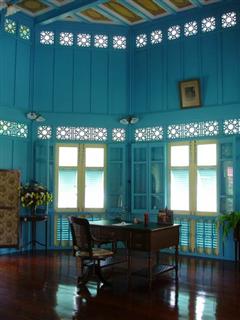 e throne. Though joyous, the retreat would be their last one together. King Rama VI died a few months later in Bangkok, only hours after his heir, a baby girl was born and brought to his bedside for a bittersweet greeting and farewell. e throne. Though joyous, the retreat would be their last one together. King Rama VI died a few months later in Bangkok, only hours after his heir, a baby girl was born and brought to his bedside for a bittersweet greeting and farewell.
Every year in Feburary there is a ten-day festival in Petchaburi honoring the three kings who brought so much attention to the province by building their summer palaces there – Rama IV, Rama V and Rama VI. Another summer palace just nearby, however, is not included in the festivities because it’s in a different province, Prachuap Kirikhan. Klai Kangwon at Hua Hin beach, is easily the highest-profile of all such palaces today, as it is the permanent residence of Thailand’s current king, Rama IX, Bhumibol Adulyadej.
Rama VII – King Prajadhipok
Rama IX – King Bhumibol Adulyadej
Klai Kangwon
Klai Kangwon was built King Prajadhipok (Rama VII) for his Queen Rambai Barni. It is the first summer palace to be built by a native Thai, Iddhidebsarn Kritakara. The name means “Far from Worries,” a possible nod to Friedrich the Great’s own summer retreat, Sans Souci. Unfortunately, the optimistic name didn’t accurately describe the king’s experience there. He was staying here in 1932 when a coup d’etat forced him from the throne and ultimately out of his beloved country forever. He died in England nine years later. Unfairly accused of embezzling money from the country by the military dictatorship, many of the king’s assets were appropriated by the government after his death. Years later, the Queen explained the reason for the dictatorship’s false accusations of embezzlement: While alive, the king would not barter Klai Kangwon to cover debts incurred by his father-in-law, Prince Svasti and so instead, the new government took what he could. Though it caused him enormous trouble, Prajadhipok’s steadfastness allowed Klai Kangwol to remain in royal hands, passing it down to his revered successor.
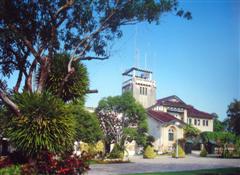
Due to the erection of a royal palace here, Hua Hin became the first seaside resort town as the well-to-do of Bangkok followed him and his retinue for their holidays. A royal pavilion was brought from Sanam Chan palace to the railway station and though it still stands there, it is not in use. Today the king travels to Hua Hin by airplane or private car.
Since Rama VII was the first king to eschew consorts in favor of a monogamous relationship with his Queen, there was no need for Klai Kangwon to mandate the traditional separation of male and female areas – rather, the palace was constructed with a division only between the royal family and its associated entourage.
Klai Kangwon appears more like a large Spanish house than a typically-ornate palace. This was a conscious decision on the part of the Thai architect, who wanted to build the most comfortable and appropriate residence given the balmy, seaside environment. Perhaps it also suggests a certain architectural humility in keeping with the changes going on in the rest of the world – overly baroque and lavish palaces had become a thing of the past for increasingly practical rulers the world over. Though magnificent, Klai Kangwon doesn’t evince the same flamboyant architectural ambition which the previous century’s kings employed in fashioning their own palaces.
The present king, Rama IX, lives most of the year at Klai Kangwon now, so the palace is open only to invited guests. Those who own villas next door must be overjoyed to have him as a full-time neighbor. And as the site of some of his happiest times, it is no wonder the king has decided to make “far from worries” his permanent home.
Like the monarchs who ruled before him, however, Rama IX’s summer palace has also been the site of some of his most trying times. Following the killing of his brother, King Rama VIII, Bhumibol himself struggled to temper the dangerous machinations of the new military dictatorship and America’s increased involvement in South-East Asia. It was at Klai Kangwon that the king sought refuge from the Thai dictatorship bent on countering his influence. And it was here that he f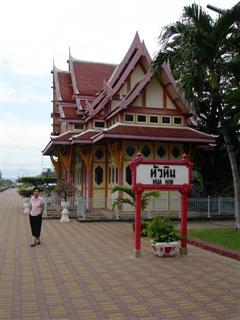 ormulated strategies to make sure power stayed in the hands of the people, that Thailand’s governance would be steered entirely by native hands. In doing so, he followed in the footsteps of his royal predecessors, visionary leaders who protected the country from the dangers that plagued its less-savvy neighbors: capitulation to extreme ideologies on one hand and intractable foreign interests on the other. Yet it was only by retreating from the Byzantine complexities of courtly life to this place, “far from worry,” that he could secure the inner space necessary to do so. ormulated strategies to make sure power stayed in the hands of the people, that Thailand’s governance would be steered entirely by native hands. In doing so, he followed in the footsteps of his royal predecessors, visionary leaders who protected the country from the dangers that plagued its less-savvy neighbors: capitulation to extreme ideologies on one hand and intractable foreign interests on the other. Yet it was only by retreating from the Byzantine complexities of courtly life to this place, “far from worry,” that he could secure the inner space necessary to do so.
Certainly the summer palaces of the Thai kings are some of the most joyous and magnificent structures in Thailand. Yet regardless of how opulent they may be, there is some of the original Buddhist monasteries in each of them: Like those early rain-retreats, each palace was a shelter from the periodic monsoons that both afflicted each king, and at the same time allowed the seeds of his inspiration a chance to take root. As King Mongkut, Rama IV showed in his own life, perhaps there is not as much difference between a monk and a king as one might otherwise expect.
|
|
|
|
All text and images © copyright Oliver Benjamin |
|
|
|
|

